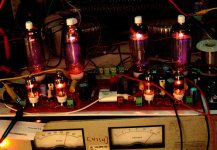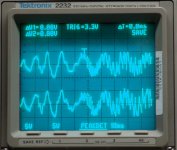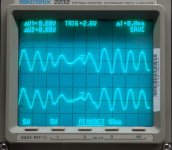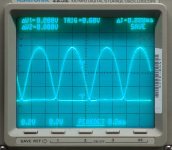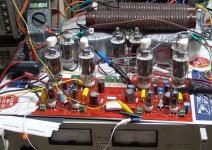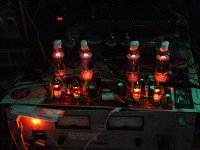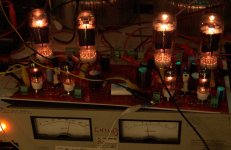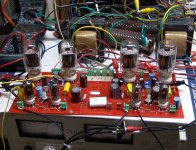(or should I say abuse).
Nah, these things are just too hard to find to abuse. Yes the watt meter said 240, but I was operating the tubes within their ratings. That voice inside my head, you know the one that keeps telling me to turn it up, convinced me to crank the power supply knob up to a litle bit over 600 volts. I could get well over 200 WPC at reasonable distortion, and I made the watt meter read 300 for a few seconds (severe clipping). The voice of reason reminded me that this is how I scattered bits of capacitor all over the room last time, so I put the knob back on 550.
I was bugged by high distortion in one channel, so today I played musical tubes. I did have one bad 6CB6 but the distortion followed the output tubes. I swapped tubes and found that the culprit is one of my NOS tubes. So now I have the 4 tubes that I got from you in the amp. All 3 of the tubes that I have suck, and two of them look brand new!
I decided that If I were to actually build an amp with this board, I would need to make a real power supply. That means that I would need a power transformer, and power transformers for 400 watt amps don't come from Walmart. I already have an Antek 4TK400 so it will have to do. In fact I have two of them.
The 4TK400 makes about 550 volts of B+ with a light load, and I am guessing a little over 500 volts if it were trying to run this beast. So I set the power supply to 500 and I can get 130 watts on one channel and 150 watts on the other.
OK, what would happen if I changed the tap on the OPT to reflect a 1250 ohm load? Over 200 watts happen. Unfortunately cranking the amp to hard clipping pegs the current meter on the power supply, which is too much current for these tubes. Turning off the lights reveal some redness in the tubes. So for now I set the OPT back to 2500 ohms.
Another thing that I discovered is that these tubes take some serious drive voltage. It takes nearly 10 volts P-P to drive this amp to clipping. A CD player won't get there. The simplest way to improve this is to find a different input tube that has more Gm and maybe play with the plate load resistors since I have way more B+ voltage than Pete ever dreamed of. The first candidate that came to mind was the 6EW6, but I couldn't find any. I did find a bunch of 6GU5's. Could a tube that has 5 grids work better than 3? Yes, gain went up, and the distortion went down. One channel has 0.78% at 50 watts and the other has 1.67%.
Now, all I have to do is hook it up to the speakers and annoy the neighbors.
Nah, these things are just too hard to find to abuse. Yes the watt meter said 240, but I was operating the tubes within their ratings. That voice inside my head, you know the one that keeps telling me to turn it up, convinced me to crank the power supply knob up to a litle bit over 600 volts. I could get well over 200 WPC at reasonable distortion, and I made the watt meter read 300 for a few seconds (severe clipping). The voice of reason reminded me that this is how I scattered bits of capacitor all over the room last time, so I put the knob back on 550.
I was bugged by high distortion in one channel, so today I played musical tubes. I did have one bad 6CB6 but the distortion followed the output tubes. I swapped tubes and found that the culprit is one of my NOS tubes. So now I have the 4 tubes that I got from you in the amp. All 3 of the tubes that I have suck, and two of them look brand new!
I decided that If I were to actually build an amp with this board, I would need to make a real power supply. That means that I would need a power transformer, and power transformers for 400 watt amps don't come from Walmart. I already have an Antek 4TK400 so it will have to do. In fact I have two of them.
The 4TK400 makes about 550 volts of B+ with a light load, and I am guessing a little over 500 volts if it were trying to run this beast. So I set the power supply to 500 and I can get 130 watts on one channel and 150 watts on the other.
OK, what would happen if I changed the tap on the OPT to reflect a 1250 ohm load? Over 200 watts happen. Unfortunately cranking the amp to hard clipping pegs the current meter on the power supply, which is too much current for these tubes. Turning off the lights reveal some redness in the tubes. So for now I set the OPT back to 2500 ohms.
Another thing that I discovered is that these tubes take some serious drive voltage. It takes nearly 10 volts P-P to drive this amp to clipping. A CD player won't get there. The simplest way to improve this is to find a different input tube that has more Gm and maybe play with the plate load resistors since I have way more B+ voltage than Pete ever dreamed of. The first candidate that came to mind was the 6EW6, but I couldn't find any. I did find a bunch of 6GU5's. Could a tube that has 5 grids work better than 3? Yes, gain went up, and the distortion went down. One channel has 0.78% at 50 watts and the other has 1.67%.
Now, all I have to do is hook it up to the speakers and annoy the neighbors.
Attachments
I made a few more tweaks. I found that I could play with the screen voltage and the bias voltage to optimize power VS distortion. I had been running the screens at 175 volts because thats what worked the best for the 6HF5's. I find that the 6KD6 / 6GU5 combination likes 150 volts. The screen current goes so low that it doesn't show up on the 0 to 300 mA analog meter. The distortion at low power levels goes down. The good channel reado 0.11% at 1 watt. The bad channel reads 0.77% at 1 watt. I set the power supply back to 520 volts, where one channel makes 160 watts and the other 140 watts. The distortion at 100 watts is 1.8% and 3.03%. Dialing the frequency down to 20Hz but leaving the power at 100 watts only changes the distortion 0.1%. Plitron makes some killer (but expensive) OPT's.
I hooked up the CD player and speakers. Yes its LOUD! I was afraid that I was going to blow up my speakers. It is still not possible to drive this amp into clipping from a CD player, but it isn't necessary. I listened for about 2 hours with the scope across the speaker leads. I never saw the amp clip once, but I did observe over 110 volts peak to peak across my "8 ohm" speakers on multiple occasions.
The scope is set on 5 volts per division with a 10X probe. That makes 50 volts per vertical division. It is also on 10mS per horizontal division. That puts the bass guitar notes in the third photo at about 100Hz. In all photos there are clean unclipped bass notes in the 80 to 100Hz range that are 80 to 110 volts P-P. No this doesn't mean that the amp is putting out 180 watts, it means that my "8 ohm" speakers are in the 10 to 15 ohm range at these frequencies. This is not uncommon with small speakers.
I hooked up the CD player and speakers. Yes its LOUD! I was afraid that I was going to blow up my speakers. It is still not possible to drive this amp into clipping from a CD player, but it isn't necessary. I listened for about 2 hours with the scope across the speaker leads. I never saw the amp clip once, but I did observe over 110 volts peak to peak across my "8 ohm" speakers on multiple occasions.
The scope is set on 5 volts per division with a 10X probe. That makes 50 volts per vertical division. It is also on 10mS per horizontal division. That puts the bass guitar notes in the third photo at about 100Hz. In all photos there are clean unclipped bass notes in the 80 to 100Hz range that are 80 to 110 volts P-P. No this doesn't mean that the amp is putting out 180 watts, it means that my "8 ohm" speakers are in the 10 to 15 ohm range at these frequencies. This is not uncommon with small speakers.
Attachments
I could have sent you some 6EW6s also to play with. I have a few of them too.
I have plenty. I just didn't have any here at the house, and I didn't feel like going to the warehouse to get them last night. That turned out to be a good thing, since I doubt that I would ever have tried the 6GU5. I plan to get some 6EW6's on the way home from church today.
I have plenty. I just didn't have any here at the house, and I didn't feel like going to the warehouse to get them last night. That turned out to be a good thing, since I doubt that I would ever have tried the 6GU5. I plan to get some 6EW6's on the way home from church today.
I gotta know - do you tune motors the same way you do with amps? Pistons can get pretty expensive. 😱
-D
I gotta know - do you tune motors the same way you do with amps? Pistons can get pretty expensive.
Not now that I know better. About 25 years ago (before the sport compact tuner crowd were even born) I got the wild hair to stuff one of Dodges new turbo motors into a 2 door Omni. You know the old formula put the biggest motor in the lightest car..... I even got to talk to Carroll Shelby on the phone since he worked for Dodge at the time. After having fun smoking Mustangs for about a year I started tuning. Bigger intercooler, more boost BOOM. Repair....repeat...BOOM. I blew that motor up several times, but only fried a piston once. Head gaskets were a different story. I finally got the short block professionally built including O ringing around the cylinders. Never blew the motor again. I started blowing up transaxles instead! 5 transaxles later I gave up.
After a trip to the roof to see if any of the halftime lasers were visible (I'm 8 miles north of the Super Bowl, and I could only detect a faint glow) I'm back to cranking on this board.
I have one 6LX6 tube and one 6LF6 tube. Some say that these are the same tube, so into the amp they went. The maximum power was only 80 watts. These tubes needed a bunch more negative bias, and more drive. More drive than the little driver tubes can make.
I have been playing with this board during the entire football game tonight. I have made an important discovery. Last night I reported some seriously low distortion readings on one channel, while the other channel refused to go below 2%. I believed that this was output tube related. I also discovered that the distortion VS output power could be tweaked by playing with screen grid voltage. Experiments tonight reveal that the situation is a bit more complex.
I have 8 6LR6 tubes that I got cheap on Ebay. They are all used, some a bit more used than others. I picked the 6 tubes that looked useable. The seller had already identified two as bad and they both look completely toasted. Together they make 26 watts at clipping from a 550 volt supply with the bias pots set for maximum current. I discovered that I could pick a pair of tubes that made awesome power ( 170 watts @3%) with good distortion when all of the trim pots were tweaked at max power. However the distortion went up as the power was reduced. WTF?
Pete alluded to the fact that some distortion cancellation was taking place. OK, last night I saw 0.11% at 1 watt and 0.77% at 50 watts, on an all pentode amp without any GNFB. Clearly Schade's magic is working here!
I have never seen it mentioned but it seems that for Schades magic to work well in a push pull amp, the transconductance in the output tubes needs to be reasonably well matched over the range of current that they will see in the amp. The range of currents seen in this amp go from cutoff to 800 mA in each tube! The first photo shows the cathode current for each tube in one channel on the scope while the amp is cranked to 180 watts. The vertical scale is 200mA per division. When you are dealing with used tubes finding a pair that really match isn't so easy. Some of the used tubes seem to lose transconductance as the current goes up. This seems to unbalance the amp. There is a sharp transition from "normal" to "broken" as the power level in increased. Swapping the two tubes within a channel moves the distortion from the top of the wave to the bottom.
Is this because I am cranking 10 times the power level out of my board than Pete intended? Will this be a problem on a more "normal" build? Can I even build something "normal"? I still have 20 brand new 6GV5's and a few other small tubes to stuff into this thing. Maybe the whole "matched tubes" thing will be fixed by using new tubes. Maybe the matching requirement diminishes as the power level is reduced. I have seen evidince of this. All will be told in due time, but I don't see powering this thing up again for at least two weeks.
I have 8 6LR6 tubes that I got cheap on Ebay. They are all used, some a bit more used than others. I picked the 6 tubes that looked useable. The seller had already identified two as bad and they both look completely toasted. Together they make 26 watts at clipping from a 550 volt supply with the bias pots set for maximum current. I discovered that I could pick a pair of tubes that made awesome power ( 170 watts @3%) with good distortion when all of the trim pots were tweaked at max power. However the distortion went up as the power was reduced. WTF?
Pete alluded to the fact that some distortion cancellation was taking place. OK, last night I saw 0.11% at 1 watt and 0.77% at 50 watts, on an all pentode amp without any GNFB. Clearly Schade's magic is working here!
I have never seen it mentioned but it seems that for Schades magic to work well in a push pull amp, the transconductance in the output tubes needs to be reasonably well matched over the range of current that they will see in the amp. The range of currents seen in this amp go from cutoff to 800 mA in each tube! The first photo shows the cathode current for each tube in one channel on the scope while the amp is cranked to 180 watts. The vertical scale is 200mA per division. When you are dealing with used tubes finding a pair that really match isn't so easy. Some of the used tubes seem to lose transconductance as the current goes up. This seems to unbalance the amp. There is a sharp transition from "normal" to "broken" as the power level in increased. Swapping the two tubes within a channel moves the distortion from the top of the wave to the bottom.
Is this because I am cranking 10 times the power level out of my board than Pete intended? Will this be a problem on a more "normal" build? Can I even build something "normal"? I still have 20 brand new 6GV5's and a few other small tubes to stuff into this thing. Maybe the whole "matched tubes" thing will be fixed by using new tubes. Maybe the matching requirement diminishes as the power level is reduced. I have seen evidince of this. All will be told in due time, but I don't see powering this thing up again for at least two weeks.
Attachments
making some progress at this end. I previously posted a pic of an HP carcase -- this was a 5328a counter/timer which I got at a hamfest for next to nothing -- (no cards, but good power supply and lot of knobs) -- the HP has a couple of die castings which have to be trimmed for a more ergonomic appearance:
The williams sonoma cake baking tins are a wee bit too small to use for Engineer's amp.
An externally hosted image should be here but it was not working when we last tested it.
The williams sonoma cake baking tins are a wee bit too small to use for Engineer's amp.
Can I even build something "normal"?
George, I think we all know the answer to that...

Keep up the good work!
Pete
George, I think we all know the answer to that...
OK, so why be normal, it's so boring. It is a safe bet that the 200W SE test amp made with clip leads and an 833A doesn't fit too many peoples definition of normal. I could see how squeezing 150+ WPC out of the red board may not exactly fit in with "normal" either. In fact most of the engineers think that playing with vacuum tubes itself isn't exactly normal. So......
My rational side keeps telling me that 30 to 50 WPC is plenty, and after spending some time with an amp that now makes over 150 WPC I have come to the realization that my already bad hearing and my speakers are both in jeopardy.
That other inner voice keeps telling me to turn it up, after all why do you have 400 watt capable OPT's if you can't use them to their fullest. I have seen that the safe limit for the large sweep tubes is around 150 WPC, but I have a bunch of "grande" sweep tubes that I havent even tried yet.
Pete, I must thank you for designing this piece of art. It has provided me (and maybe a few other diy'ers) several hours of fun and amusement. It will provide much more when I have more time. I made a similar but much smaller design about a year ago using 6AU6's and 6AQ5's. It used some 7 pin experimenters PC boards made up by Dsavitsk. I am still trying to find it to see if it reacted the same with mismatched output tubes. This board has stirred up a big batch of new ideas. Many are far from "normal" things, like what would happen when you tried Schade feedback with screen drive? Does the tube mismatch get worse if 4 output tubes per channel are used? Will it work with mosfet buffers for AB2 mode? I think some kind of big breadboard will be needed to try all of this out.
I will be out of town next weekend. I am going to the Orlando hamfest, and to ESRC's multi-million tube warehouse. I have a shopping list of tubes to try in this board. I must warn people that my list is largely populated with more "normal" and even wimpy tube types though.....Except for the 4D22's
OK, like a junkie looking for a fix, I just can't leave it alone. My shopping list for next weekend is too big. I still have tubes from last years hamfests that I haven't even tested yet. So I need to stuff a few tubes in the board before I go so I can decide to cross some numbers off of the list, or add a few. In an attempt to venture back towards "normal" I will be testing smaller tubes. Tubes that don't even have plate caps. You know, wimpy tubes. For the first test I found 5 tubes. I think that I got them from AES when they had the 50% off sale a while back. They are the biggest tubes in my collection that don't have plate caps.
WARNING!!!! These tubes are not directly compatible with this board. WARNING!!!!
I got a rather nice surprise when I twisted the dials on these guys. In fact I am not even going to reveal the type number until I make some phone calls tomorrow.
Again plugging these tubes into an unmodified board WILL blow stuff up. Fortunately the mods are easy. In fact after I get some more tubes and do some more testing I may detail how to build the whole thing, but first I need to figure the power supply out.
What is so special? Well first off no ridiculous voltages are used, the plate supply is 450 volts. Second the amp is completely stable. It ran at full power for half an hour with no bias drift and nothing glows. Third the distortion numbers are unreal, and no tube matching was performed. The data below was generated using my monster Plitron OPT's wired to present a 2500 ohm load. Technically I am bending the plate dissipation specs a bit with this load at full power, but no glow was noted even by the camera (which "sees" near infared) in a totally dark room. I plan to retest with "regular" 3300 ohm OPT's which will generate less power. I guess I need to build Petes interface and get my old computer running so I can plot the distortion spectra.
POWER DISTORTION
1 watt 0.419%
10 watts 0.390%
25 watts 0.396%
50 watts 0.942%
75 watts 2.57%
100 watts 4.59%
WARNING!!!! These tubes are not directly compatible with this board. WARNING!!!!
I got a rather nice surprise when I twisted the dials on these guys. In fact I am not even going to reveal the type number until I make some phone calls tomorrow.
Again plugging these tubes into an unmodified board WILL blow stuff up. Fortunately the mods are easy. In fact after I get some more tubes and do some more testing I may detail how to build the whole thing, but first I need to figure the power supply out.
What is so special? Well first off no ridiculous voltages are used, the plate supply is 450 volts. Second the amp is completely stable. It ran at full power for half an hour with no bias drift and nothing glows. Third the distortion numbers are unreal, and no tube matching was performed. The data below was generated using my monster Plitron OPT's wired to present a 2500 ohm load. Technically I am bending the plate dissipation specs a bit with this load at full power, but no glow was noted even by the camera (which "sees" near infared) in a totally dark room. I plan to retest with "regular" 3300 ohm OPT's which will generate less power. I guess I need to build Petes interface and get my old computer running so I can plot the distortion spectra.
POWER DISTORTION
1 watt 0.419%
10 watts 0.390%
25 watts 0.396%
50 watts 0.942%
75 watts 2.57%
100 watts 4.59%
Attachments
I hooked up the "normal" sized OPT's, wired for a 3300 ohm load. As expected the power output dropped. Instead of 100 WPC I was only getting 75 🙁 So, what to do? Turn up the voltage. I could get my 100 watts back at 530 volts, but these OPT's can't do that, can they? I dialed the supply back to 475 and hooked up some music. As I said before this board ROCKS.
The big tubes connected to the big OPT's definitely had bigger sound, bigger bass and total effortlessness. I did feel however that the amp could explode at any minute.
Now there have been numerous discussions on this forum about the right way to design and build an OPT. The discussions all have technical merrit and explain how to wind multiple interleaved windings and properly interconnect them to make the best possible OPT. What these discussions dont tell me is how these ultra cheap OPT's that were made for use in guitar amps, that have no interleaving at all, measure and sound so good! I have used these OPT's with everything from EL84's to 300B's and they just work.
Either way this amp works and it has been playing for over an hour. After cranking some Billy Idol at near clipping, the idle current returned to exactly 40 mA per tube when I turned down the volume. Despite the clip lead connections, the total hum and noise is 2.2 mV across the speakers.
I fully intended to test some different tubes tonight, but that isn't going to happen. I would rather crank it up!
The big tubes connected to the big OPT's definitely had bigger sound, bigger bass and total effortlessness. I did feel however that the amp could explode at any minute.
Now there have been numerous discussions on this forum about the right way to design and build an OPT. The discussions all have technical merrit and explain how to wind multiple interleaved windings and properly interconnect them to make the best possible OPT. What these discussions dont tell me is how these ultra cheap OPT's that were made for use in guitar amps, that have no interleaving at all, measure and sound so good! I have used these OPT's with everything from EL84's to 300B's and they just work.
Either way this amp works and it has been playing for over an hour. After cranking some Billy Idol at near clipping, the idle current returned to exactly 40 mA per tube when I turned down the volume. Despite the clip lead connections, the total hum and noise is 2.2 mV across the speakers.
I fully intended to test some different tubes tonight, but that isn't going to happen. I would rather crank it up!
Attachments
Not now that I know better. About 25 years ago (before the sport compact tuner crowd were even born) I got the wild hair to stuff one of Dodges new turbo motors into a 2 door Omni. You know the old formula put the biggest motor in the lightest car..... I even got to talk to Carroll Shelby on the phone since he worked for Dodge at the time. After having fun smoking Mustangs for about a year I started tuning. Bigger intercooler, more boost BOOM. Repair....repeat...BOOM. I blew that motor up several times, but only fried a piston once. Head gaskets were a different story. I finally got the short block professionally built including O ringing around the cylinders. Never blew the motor again. I started blowing up transaxles instead! 5 transaxles later I gave up.
Whoa, whoa, whoa. Are you telling me you are the guy who gave Carroll the idea for the Omni GLH?!?

-D
OK, like a junkie looking for a fix, I just can't leave it alone. My shopping list for next weekend is too big. I still have tubes from last years hamfests that I haven't even tested yet. So I need to stuff a few tubes in the board before I go so I can decide to cross some numbers off of the list, or add a few. In an attempt to venture back towards "normal" I will be testing smaller tubes. Tubes that don't even have plate caps. You know, wimpy tubes. For the first test I found 5 tubes. I think that I got them from AES when they had the 50% off sale a while back. They are the biggest tubes in my collection that don't have plate caps.
WARNING!!!! These tubes are not directly compatible with this board. WARNING!!!!
I got a rather nice surprise when I twisted the dials on these guys. In fact I am not even going to reveal the type number until I make some phone calls tomorrow.
Again plugging these tubes into an unmodified board WILL blow stuff up. Fortunately the mods are easy. In fact after I get some more tubes and do some more testing I may detail how to build the whole thing, but first I need to figure the power supply out.
What is so special? Well first off no ridiculous voltages are used, the plate supply is 450 volts. Second the amp is completely stable. It ran at full power for half an hour with no bias drift and nothing glows. Third the distortion numbers are unreal, and no tube matching was performed. The data below was generated using my monster Plitron OPT's wired to present a 2500 ohm load. Technically I am bending the plate dissipation specs a bit with this load at full power, but no glow was noted even by the camera (which "sees" near infared) in a totally dark room. I plan to retest with "regular" 3300 ohm OPT's which will generate less power. I guess I need to build Petes interface and get my old computer running so I can plot the distortion spectra.
POWER DISTORTION
1 watt 0.419%
10 watts 0.390%
25 watts 0.396%
50 watts 0.942%
75 watts 2.57%
100 watts 4.59%
Haha I really want to know what those are, they sound like some very solid tubes and the power output looks nice. Keep up the experiments George, your posts about your them are fascinating. I'll be interested to see what else you can achieve with this board.
Are you telling me you are the guy who gave Carroll the idea for the Omni GLH?!?
Not even close. The Shelby Charger (a tweaked 2 door Omni) had been around since 1982. It ran the usual normally aspirated 2.2L 4 banger with higher comprssion and a bigger camshaft to make about 110 HP. I was driving a 1982 Charger 2.2 with the plain jane 84 HP motor when I blew the transaxle. I was junkyard shopping for a transaxle when I spotted a freshly wrecked 1984 Dodge Daytona Turbo (142 HP 2.2L). The motor / transaxle looked like it would fit into the Charger with only minimal "persuasion". I got the phone number for the Chrysler Shelby Performance Center and called to find out if my guess was correct. I asked my question to the person who answered the phone who replied "hold on". The next voice I heard was the "man" himself. He told me that not only would it fit, he was looking at the prototype for the 1985 Shelby Charger which was made out of a 1982 Charger and a 1984 turbo drive train. He then transfered me to the guy who actually built the car! His name was Steve and he explained that my problems would not be physical assembly, but electrical and fuel delivery. I told him that I was an EE and he even faxed me the wiring diagram to make my own wiring harness. Of course that was just the beginning of the madness that lasted about 8 years.
The Omni GLH and the Shelby Charger Turbo came out about 6 months after my call. The Omni and Charger were loosely based on the VW Rabbit platform. In fact the 1978 through 1980 versions had VW 1.7L engines in them. They inherited the VW "salute", which was the tendency to lift the inside rear tire several inches off the ground during hard cornering. Rumor has it that the development team were reviewing video from a track testing session where Carroll made the comment that the little Omni Goes Like Hell. Hence the name.
Haha I really want to know what those are, they sound like some very solid tubes and the power output looks nice.
OK, I just got off of the phone. It turns out that the mystery tube isn't too common, and probably won't be found outside of the US. The good news is that Stan at ESRC ( 407-826-5808) has at least 60 of them in stock and they are $4 each! He also said that no one has been buying them.
The number, Oh you want the number.....6HJ5
If you have any 6HD5 they will work too, but they are even rarer and cost more, $5 !
Again DO NOT simply plug these into the red board without modifications. The pinout is NOT the same G1 and G2 are swapped which will fry parts. I made a simple reversible mod to my board last night. No traces were cut. If I remember correctly R16 and R20 are removed. R6 and R3 are installed. The cold end of R8 and R11 are moved to the holes formerly occupied by R20 and R16. Same deal for the other channel.
I would not recommend trying this yet unless you understand what you are doing until I verify and photograph what I did.
Also it should be understood that simply sticking bigger tubes into any amplifier will not make a big change in the power output. They simply remove the limitations imposed by the small tubes, allowing you to make other changes to get more power. These changes usually invlove raising the B+ voltage, lowering the load impedance or both.
...of course that was just the beginning of the madness that lasted about 8 years.
Great story, George. I know all about the madness...I've been driving turbo Chryslers for about 20 years (since I learned to drive my mom's '86 LeBaron GTS). I never got into the L-bodies, but I still drive a 1986 Daytona Turbo Z daily. 20psi of boost with snow tires is a handful, even when there isn't any snow. 🙂 That is my "slow" car.
I like these cars because they are so stupid-simple and it doesn't take much to make lots of power. Parts are becoming scarce, though, so I know my daily-driving days are numbered.
Back on topic...ugh. Your experiments drive me crazy. I've been resisting the urge to buy one of these boards. I don't need yet another breadboarded amp floating around but I am intrigued by what is possible with Pete's board.
No...no...don't click on "But It Now"....
Not even close. The Shelby Charger (a tweaked 2 door Omni) had been around since 1982. It ran the usual normally aspirated 2.2L 4 banger with higher comprssion and a bigger camshaft to make about 110 HP. I was driving a 1982 Charger 2.2 with the plain jane 84 HP motor when I blew the transaxle. I was junkyard shopping for a transaxle when I spotted a freshly wrecked 1984 Dodge Daytona Turbo (142 HP 2.2L). The motor / transaxle looked like it would fit into the Charger with only minimal "persuasion". I got the phone number for the Chrysler Shelby Performance Center and called to find out if my guess was correct. I asked my question to the person who answered the phone who replied "hold on". The next voice I heard was the "man" himself. He told me that not only would it fit, he was looking at the prototype for the 1985 Shelby Charger which was made out of a 1982 Charger and a 1984 turbo drive train. He then transfered me to the guy who actually built the car! His name was Steve and he explained that my problems would not be physical assembly, but electrical and fuel delivery. I told him that I was an EE and he even faxed me the wiring diagram to make my own wiring harness. Of course that was just the beginning of the madness that lasted about 8 years.
The Omni GLH and the Shelby Charger Turbo came out about 6 months after my call. The Omni and Charger were loosely based on the VW Rabbit platform. In fact the 1978 through 1980 versions had VW 1.7L engines in them. They inherited the VW "salute", which was the tendency to lift the inside rear tire several inches off the ground during hard cornering. Rumor has it that the development team were reviewing video from a track testing session where Carroll made the comment that the little Omni Goes Like Hell. Hence the name.
Either way, very cool. I've never been much into American cars, but I can totally respect 'the madness'. Personally, I'm a junkie for the BMW E30 cars(which are approximately from the same era as the Charger and Omni GLH).
-D
Back on topic...ugh. Your experiments drive me crazy. I've been resisting the urge to buy one of these boards. I don't need yet another breadboarded amp floating around but I am intrigued by what is possible with Pete's board. No...no...don't click on "But It Now"....
So far I have resisted the temptation to buy another board. I bought the first one because it was very similar to a project that I started a while back that never got very far. It worked great but you can only turn the knob up so far on a pair of 6AQ5's. There is only a small zone between the normal operating point and the melting point (literally). I have sucked air into a few of these little tubes.
I saw this board and decided that it would be a fun toy to experiment with. It has provided me with a lot of fun and a bit of excitement, and a few fried parts! I have come up with at least a dozen new experiments to try when I have the time. Unfortunately some involve octal tubes, screen drive and mosfets which are beyond the reach of the red board. I have resisted the temptation to stick some 500 volt caps in the board and crank the voltage any higher. I don't think that any of the big tubes that I have (all well used) can take much more than 200 WPC. I would like to see how far some of the super fat 6LW6's (octal) will go, and I have plenty of new ones. I'm thinking that it would be cool to design a little power supply board with a few outputs to run this board and a few other amps, then make a couple of single channel boards with BIG octal tubes and mosfet drivers, and then.....Yeah, like I have time....Back to reality.....this never happened when I built the 6AU6 / 6AQ5 amp. That's why I bought the red board, because it was already made! I got one of Petes sound card buffers too, now all I need to do is build it.
There are however plenty of experiments that I can try with this board. I have 20 6HJ5's and a bunch of JJ EL84's waiting for me in Orlando. Maybe I will arrange a showdown between a dual Simple P-P amp and the red board running at the same B+ voltage through the same OPT's, both at say 40 or 50 WPC, with all new tubes in each.....Could be interesting.
I never got into the L-bodies, but I still drive a 1986 Daytona Turbo Z daily.....Personally, I'm a junkie for the BMW E30 cars
I have owned three 2 door L bodies (Chargers) one 4 door (an Omni that I bought for $100), a G body (Daytona Turbo), and a Shadow convertible. They were a cheap (and underestimated) way to go fast in the early 80's. I have never been a BMW fan but I used to get smoked regularly at the autocross races by an old 2002. I had a lot of fun dusting 5 liter Mustangs with my 82 Charger (on the track of course), but the most awesome deal was the "gold chains disco" guy in the late 80's Vette that had the most astonished look on his face when I went passed him at a ridiculous speed. I won't mention any numbers but I was bouncing off of a 7200 RPM rev limiter in 5th gear on a long stretch of deserted road.
Now 20 some odd years later I drive a rather beat up Volvo station wagon that my father left behind when he passed. No one in the family even wanted it. My brothers kids said that they would be laughed out of high school if they showed up in it.
That's why I bought the red board, because it was already made! I got one of Petes sound card buffers too, now all I need to do is build it.
That's pretty much why I bought your boards, George. I could have easily built either of yours or anyone else's SE P-t-P but the amount of time I get to spend on hobbies tends to be in short bursts. I had an opening there and the PCB let me make a lot of progress really fast. I got one amp completely done (SSE) and the other up and running with a partially built chassis (TSE) in a couple of months. A record for me for sure.
I am itching to build another PP amp for my office and a PCB-based amp is a fast road to success. This amp is a little large, though.
I have owned three 2 door L bodies (Chargers) one 4 door (an Omni that I bought for $100), a G body (Daytona Turbo), and a Shadow convertible. They were a cheap (and underestimated) way to go fast in the early 80's.
Very cool. A friend of mine has had dozens of GLH Omni's pass through his back yard. Most are used-up and they get parted, but he has a few gems and an entire storage building stuffed with cars are parts. I'm mostly a P-body guy...first car was an 87 Sundance coupe, then an 87 Shadow coupe, then an 88 Shadow ES coupe, and then finally an 87 Shelby CSX. All were turbo, obviously. 🙂 I replaced the 88 Shadow with the 86 Turbo Z about 6 years ago but I still have the CSX. It's not really an 86 anymore...just the shell.
Anyway...it's too late for me. I've clicked it.
- Home
- Amplifiers
- Tubes / Valves
- Posted new P-P power amp design
